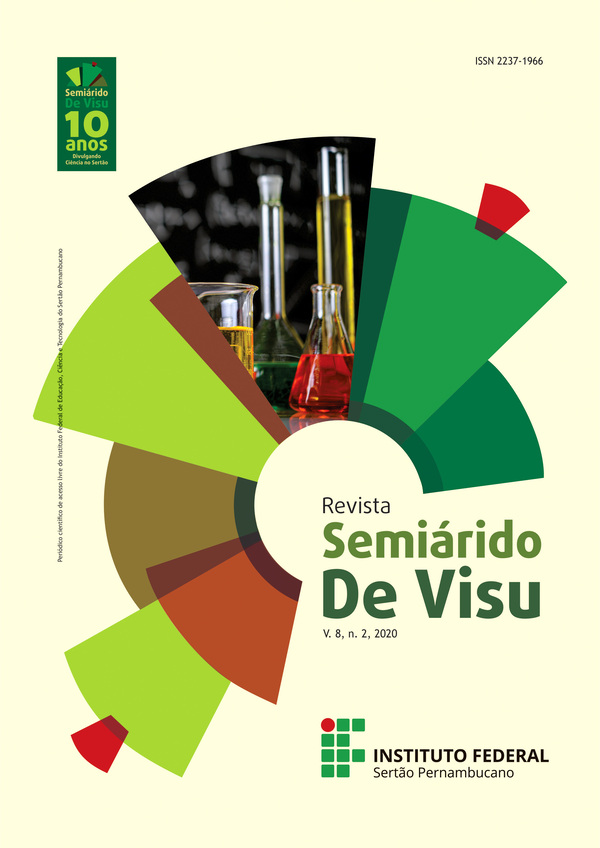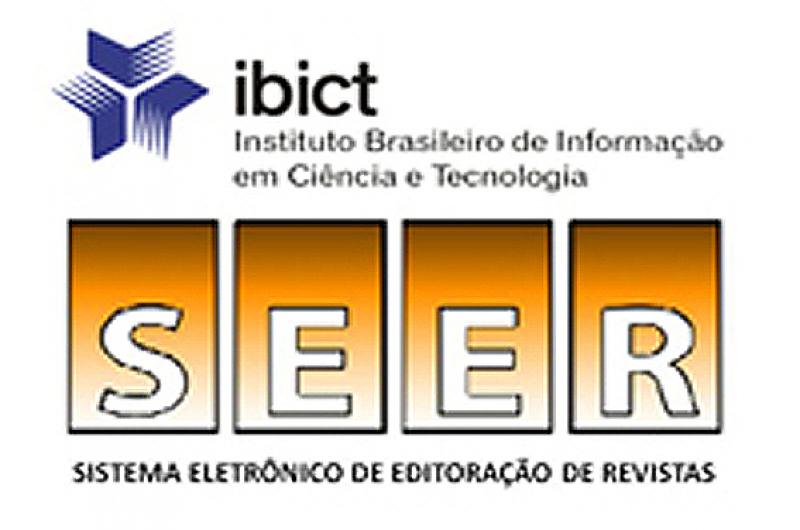Use of capim santo essential oil as a nutritional additive in the diet of juvenile piau
Visualizações: 419DOI:
https://doi.org/10.31416/rsdv.v8i2.42Keywords:
fitoaditive, native fish, feedAbstract
This study aimed to evaluate the effect of the essential oil of capim santo Cymbopogon citratus on the
performance of juveniles of true piau when added to the diet. The experiment was carried out at the
Pisciculture Laboratory, in a completely randomized design, with four treatments (diets with increasing
levels of essential oil: 0; 0.5; 1.0 and 1.5 mL/kg in commercial feed) and seven replications. The
essential oil of capim santo was diluted with cereal alcohol and sprayed with commercial feed. The fish
were distributed in 28 boxes of 100 L, fed twice a day. At the end, zootechnical parameters were
evaluated: average weight gain, specific growth rate and survival. There was no significant difference
between treatments, for the parameters: weight gain and specific growth rate, however, the inclusion
of 0.5 mL / kg (T2) promoted 100% survival.
References
ACAR,U.;KESBIÇ,O.S.;SEVDAN YILMAZ, S.; GÜLTEPE, N.; ALITÜRKER,A. Evaluation of the effects of essential oil extracted from sweet orange peel (Citrus sinensis) on growth rate of tilapia (Oreochromis mossambicus) and possible disease resistance against Streptococcus iniae. Aquaculture, v.437, p.282–286,2015.
ANDRADE, B. F. M. T.; BARBOSA, L. N.; PROBST,I.S.;FERNANDES JUNIOR, A. Antimicrobial activity of essential oils. Journal of Essential Oil Research, v.1, p. 34-40, 2014.
BAKALLI, F; AVERBECK ,S; AVERBECK, D; IDAOMAR, M. Biological effects of essential oils: a review. Food and Chemical Toxicology, v. 46, p.446-475, 2008.
BALDISSERROTO, B.; GOMES, L.C.; HEINZMANN, B.M,; CUNHA, M.A. Farmacologia aplicada à aquicultura. Santa Mari, RS: Ed. UFMS, 656 p., 2017.
BANDEIRA JR, G.; PÊS, T.S.;SACCOL, E.M.H.; SUTILI, F.J.; ROSSI JR, W.R.; MURARI, A.L.; HEINZMANN, B.M.; PAVANATO, M.A.; VARGAS, A.C.; SILVA, L.L.; BALDISSEROTTO, B. Potential uses of Ocimum gratissimum and Hesperozygis ringens essential oils in aquaculture. Industrial Crops and Products, v.97, p.484-491, 2017.
BERALDO, C.; DANELUZZI, N.S.; SCANAVACCA, J.; DOYAMA, J.T.; FERNANDES JÚNIOR, A.; FENIMAN, C.M. Eficiência de óleos essenciais de canela e cravo-da-índia como sanitizantes na indústria de alimentos. Pesquisa Agropecuária Tropical, v.43, p. 436-440,2013.
BRITSKI, H.A.; BIRINDELLI, J.L.O.; GARAVELLO, J.C. A new species of Leporinus Agassiz, 1829 from the upper Rio Paraná basin (Characiformes, Anostomidae) with redescription of L. elongatus Valenciennes, 1850 and L. obtusidens (Valenciennes, 1837). Papéis Avulsos da Zoologia, Volume v. 52, p.441-475, 2012.
CAMPECHE, D.F.B.;BALZANA, L.; FIGUEIREDO, R.C.R.; BARBALHO, M.R.S.;REIS, F.J.S.; MELO, J. F.B. Peixes nativos do Rio São Francisco adaptados para cultivo. Petrolina: Embrapa Semiárido, 20 p., 2011.
CARVALHO, I.R.; CARDOSO, A.C.; VILAR, F.R.C.; PRATES, V.L.; RAMALHO, R.C.; DANTAS, F.H.A.; GOMES, L.N. Composição química do óleo essencial de Cymbopogon citratus (capim santo) cultivada com as práticas agroecológicas no perímetro irrigado de Petrolina/PE. Anais do Congresso Internacional Interdisciplinar em Extensão Rural e Desenvolvimento-CIIERD, 2018.
FURLAN,M.R.;MARTINS,R.C.C.; RODRIGUES, E. SCALCO, N.; NEGRI,G.; LAGO, J.H.G. Variação dos teores de constituintes voláteis de Cymbopogon citratus (DC) Staf, Poaceae, coletados em diferentes regiões do Estado de São Paulo. Revista Brasileira de Farmacognosia v.20, p. 686-691, 2010.
GOBBO-NETO,L.;LOPES,N.P. Plantas medicinais: fatores de influência no conteúdo de metabólitos secundários. Química Nova, v.30, p.374–381,2007.
LORENZI, H; MATOS, F. J. A.; Plantas medicinais no Brasil, nativas e exóticas. São Paulo: Instituto Plantarum de Estudos da Flora LTDA, 2002.
MAZZARRINO, G.; PAPARELLA, A.; CHAVES-LÓPEZ,C.; FABERI, A.; SERGI, M.; SIGISMONDI, C.; COMPAGNONE,D.; SERIO, A. Salmonella enterica and Listeria monocytogenes inactivation dynamics after treatment with selected essential oils. Food Control, v. 50, p. 794-803, 2015.
OLIVEIRA, M.M.M.; BRUGNERA, D.F.; CARDOSO, M.G.; GUIMARÃES, L.G.L.; PICCOLI, R.H. Rendimento, composição química e atividade antilisterial de óleos essenciais de espécies de Cymbopogon. Revista Brasileira de Plantas Medicinais, Botucatu, v.13, p.8-16,2011.
OUSSALAH, M.; CAILLET, S.;SAUCIER, L.; LACROIX, M. Inhibitory effects of selected plant essential oils on the growth of four pathogenic bacteria: E. coli 0157:H7, Salmonella typhimurium, Spaphylococcus aureus e Listerria monocytogenes. Food Control, 2006.
PEREIRA, P.S.; PAULA, L.L.R.J. Ações terapêuticas do capim-santo: uma revisão de literatura therapeutic actions of grass-saint: a literature review. Revista Saúde em Foco, v.10, p.259-263,2018.
PRINS, C. L. et al. Efeitos de confinamento do sistemaradicular sobre capim-limão (Cymbopogon citratus). Revista Ciência Agronômica, v. 39, n. 03, p. 416-421, 2008.
SANTOS, A.; PADUAN, R.H.; GAZIN, Z.C.; JACOMASSI, E.; D’OLIVEIRA, P.S.; CORTEZ, D.A.G.; CORTEZ, L.E.R.Determinação do rendimento e atividade antimicrobiana do óleo essencial de Cymbopogon citratus (DC.) Stapf em função de sazonalidade e consorciamento. Revista Brasileira de Farmacognosia; v. 19, p. 436-441,2009.
SEMEN, E.; HIZIROGLU. Production, yield and Derivatives of Volatile Oils from Eastern Redcedar (Jeniperus virgianaL.), American Journal Environmental Sciences, 1(2), p. 133-138, 2005.
SHARMA, R. et al. Fish Proteins in Coronary Artery Disease Prevention Amino Acid–Fatty Acid Concept. In: WATSON, R. R. e PREEDY, V. R. (Ed.). Bioactive Food as Dietary Interventions for Cardiovascular Disease. USA: Elsevier, cap. 32, p.525–549, 2013.
SILVA, F. FERREIRA, S. QUEIROZ, J.A.; DOMINGUES, F.C. Coriander (Coriandrum sativum L.) essential oil: its antibacterial activity and mode of action evaluated by flow cytometry. Journal of Medical Microbiology, v.60, p.1479-1486,2011.
SIMÕES, C. M. O.; SCHENKEL, E. P.; GOSMANN, G.; MELLO, J. C. P.; MENTZ, L. A.; PETROVICK, P. R. Farmacognosia: da planta ao medicamento. Ed. 6a, Porto Alegre, ED. UFRGS, 1102 p., 2007.
SOUZA,E.M.;SOUZA,R.C.;COSTA, M.M.;PINHEIRO, C.G.; HEINZMANN,B.M. COPATTI, C.E. Chemical composition and evaluation of the antimicrobial activity of two essential oils. Boletim do Instituto de Pesca, v.44, p.1-4, 2018.
SOUZA, E.M.; SOUZA, R.C.;MELO, J.B.M.; COSTA, M.M.; SOUZA,A.M.;COPATTI, C.E. Evaluation of the effects of Ocimum basilicum essential oil in Nile tilapia diet: growth, biochemical, intestinal enzymes, haematology, lysozyme and antimicrobial challenges. Aquaculture, v. 504, p.7-12, 2019.
SOUZA, R.C.; BALDISSEROTTO, B.; MELO, J.F.B.; COSTA, M.M.; SOUZA, E.M.; COPATTI, C.E. Dietary Aloysia triphylla essential oil on growth performance and biochemical and haematological variables in Nile tilapia. Aquaculture, v. 519, p. 1-7, 2020.
TAITSON, P.F.; CHAMI, E.; GODINHO, H.P. Gene banking of the neotropical fish Leporinus obtusidens (Valenciennes, 1836): A protocol to freeze its sperm in the field. Animal Reproduction Science, v.105,p. 283-291, 2008.
VALLADÃO,G.M.R.;GALLANI,S.U.; PILARSKI, F. Phytotherapy as an alternative for treating fish disease. Journal of Veterinary Pharmacology and Therapeutics, v. 38, p. 417-428,2015.
VAZZOLER, A.E.A.M. Biologia da reprodução de peixes teleósteos : teoria e prática. Maringá : EDUEM ; São Paulo : SBI, 1996. 169 p. : il.
ZHENG,Z.L.;TAN,J.Y.W.;LIU,H.Y.;ZHOU, X.H.;XIANG, X.;WANG, K.Y. Evaluation of oregano essential oil (Origanum heracleoticum L.) on growth, antioxidant effect and resistance against Aeromonas hydrophila in channel catfish (Ictalurus punctatus). Aquaculture, p.214–218, 2009.
ZEPPENFELD, C. C.; HERNÁNDEZ, D. R.; SANTINÓN, J. J.; HEINZMANN, B. M.; DA CUNHA, M. A.; SCHMIDT, D.; BALDISSEROTTO, B. Essential oil of Aloysia triphyllaas feed additive promotes growth of silver catfish (Rhamdia quelen). Aquaculture Nutrition,v. 22, p. 933-940, 2015.















